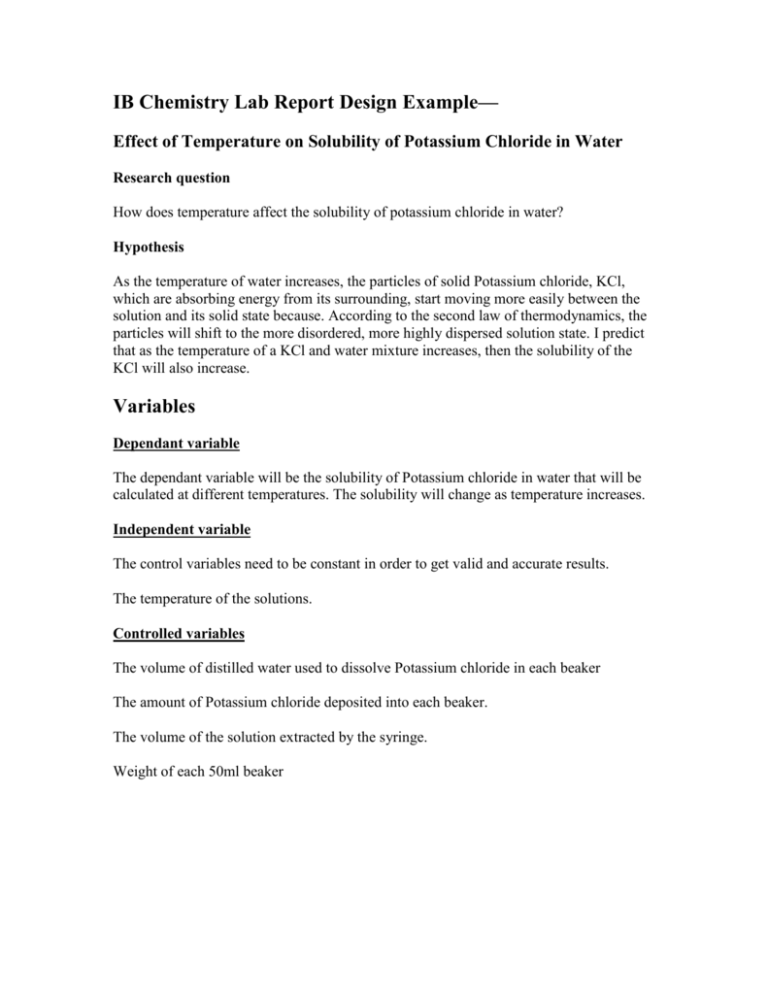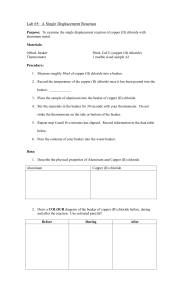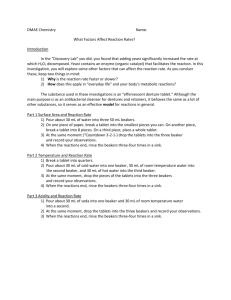IB Chemistry Lab Report Design Example—
advertisement

IB Chemistry Lab Report Design Example— Effect of Temperature on Solubility of Potassium Chloride in Water Research question How does temperature affect the solubility of potassium chloride in water? Hypothesis As the temperature of water increases, the particles of solid Potassium chloride, KCl, which are absorbing energy from its surrounding, start moving more easily between the solution and its solid state because. According to the second law of thermodynamics, the particles will shift to the more disordered, more highly dispersed solution state. I predict that as the temperature of a KCl and water mixture increases, then the solubility of the KCl will also increase. Variables Dependant variable The dependant variable will be the solubility of Potassium chloride in water that will be calculated at different temperatures. The solubility will change as temperature increases. Independent variable The control variables need to be constant in order to get valid and accurate results. The temperature of the solutions. Controlled variables The volume of distilled water used to dissolve Potassium chloride in each beaker The amount of Potassium chloride deposited into each beaker. The volume of the solution extracted by the syringe. Weight of each 50ml beaker Materials 6 Syringes 1 Heating plate 6 distinctly labeled 50ml Beakers 1 Electric Balance 6 Stirring Rods Distilled Water 6 distinctly labeled 100ml Beaker Controlling the variables The mass of Potassium chloride and the volume of distilled water introduced into each beaker should be recorded in order to allow the experimenter to determine the molar concentration of Potassium chloride in water. Since the same amount of water and Potassium chloride are used in each beaker throughout the whole experiment, these variables are the least likely to be the sources of errors. All 6 solutions will be supersaturated in Potassium chloride. If the solutions were not supersaturated, an increase in solubility will not be detectable. In order for all the solutions be subjected to the same experimental conditions, the same amount of time dedicated for stirring should be the same in all 6 100ml beakers. The use of different syringes for the extraction of the Potassium chloride and distilled water solution from each beaker avoids the possibility of contamination in the case where the same syringe was used in all 6 beakers. The needle of the syringe should be placed at the midpoint between the surface of the solution and the bottom of the beaker upon extraction. This is because of it were placed at the surface of the solution some air particles might enter the syringe, and if it were placed at the bottom of the beaker some undissolved particles might be extracted, thereby leading to an increase in the actual concentration of the dissolved salt. The weight of each 50ml beaker (used for weighing the mass of dissolved Potassium chloride after the evaporation of water) should be recorded. If the experimenter were to weigh the mass of one beaker and take it as a default mass, the latter may be a source of error. In order to minimize errors and to "place" the solutions in the same environment, the same volume should be extracted from each solution using the syringes. After heating the extracted solution in the 50ml beaker for weighing purposes, some of the water might condense back into the liquid state (in the form droplets), thereby leading to an increase in the calculated weight of Potassium chloride. Therefore after evaporation has occurred and while the 50ml beaker is still hot, the beaker should be immediately weighed. Procedure Weigh each of the 50ml beakers labeled 1, 2, 3, 4, 5 and 6 and record their masses. Introduce 100ml of distilled water into beakers 1 through 6. Beakers 1, 2, 3, 4, 5 and 6 are held at 0°C, 10°C, 20°C, 30°C, 40°C and 50°C respectively. Dissolve 50 grams of Potassium chloride into each beaker by using a stirring rod. The stirring in all 6 beakers should last 10 minutes. Insert the syringe at the midpoint between the solution's surface and the bottom of the beaker and extract 40ml as such from each solution. Push the contents of each syringe containing samples from the solutions in beakers 1, 2, 3, 4, 5 and 6 into the 50ml beakers labeled 1, 2, 3, 4, 5 and 6 respectively. Heat each of the 50 ml beakers until complete evaporation of the water occurs, and then immediately place each beaker on the balance and record the mass. By subtracting from the combined mass of (1) the salt residue from the evaporated extracted solution and (2) the 50 ml beaker, the mass of the corresponding 50ml beaker, the mass of the salt dissolved in the extracted solution can be obtained. The number of moles can be calculated, by using the formula n= m/MM , where m is the mass of the salt and MM the molar mass, which is equal to 74.60g/mol . The number of moles is then divided by the volume of the extracted sample (40ml). The obtained concentration is then multiplied by a factor of 5, in order to get the concentration of the initial solution. As expected, the solubility will be directly proportional to the temperature, for as the temperature increases so will the molar concentration of KCl in distilled water.




